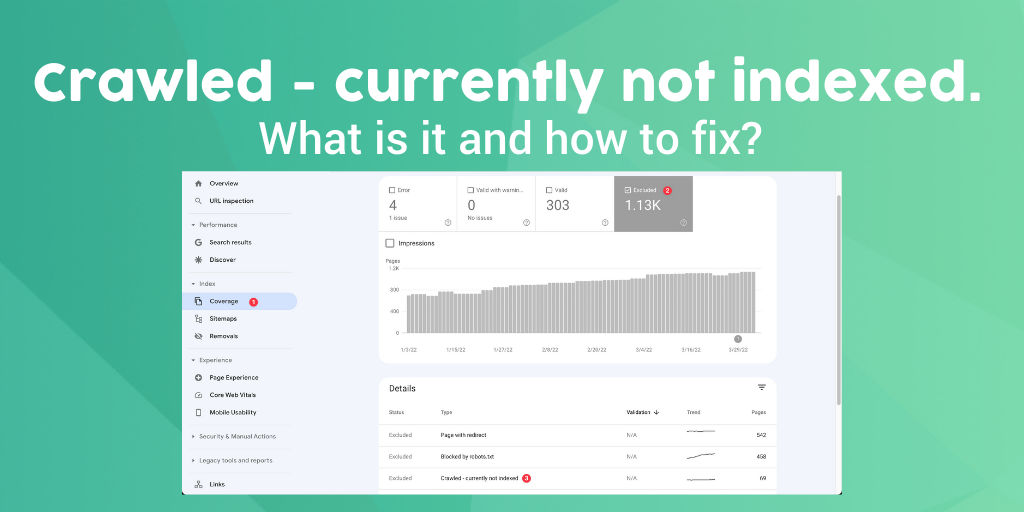Crawled – currently not indexed. What is it and how to fix?
‘Crawled – currently not indexed’ is an excluded status for pages that Google has crawled but decided not to add to its search index. This means the URL will not appear in search results.
Google doesn’t directly clarify why a page gets this status, but we know these pages often receive this status when Google considers it doesn’t reach a quality threshold to get indexed.
In this article, we will focus on how to fix ‘Crawled – currently not indexed’ and improve the odds of a page showing up in the search results.
See ‘Discovered – currently not indexed’ if Google hasn’t crawled the page you want to index.
This article makes up part of our Google Search Console tutorials and training section, make sure to check the others out.
‘Crawled – currently not indexed’ is an excluded status for pages that Google has crawled but decided not to add to its search index. This means the URL will not appear in search results.
Google doesn’t directly clarify why a page gets this status, but we know these pages often receive this status when Google considers it doesn’t reach a quality threshold to get indexed.
In this article, we will focus on how to fix ‘Crawled – currently not indexed’ and improve the odds of a page showing up in the search results.
See ‘Discovered – currently not indexed’ if Google hasn’t crawled the page you want to index.
This article makes up part of our Google Search Console tutorials and training section, make sure to check the others out.
How to fix Crawled – currently not indexed
Below is a list of common issues causing pages to be ‘Crawled – currently not indexed’ and what possible solutions to make Google index them.
Improve internal linking
Google might decide that a page isn’t worth indexing if your site has a poor internal link structure or the page doesn’t have internal links. A page without any link pointing to it is called an orphan page.
To fix orphan pages or improve the internal linking structure, start by going to an existing page on your site, find a section of the article related to the topic page you want Google to index, and add a link.
You can internal linking opportunities by doing a site-based search in Google for the keyword the orphan page is targeting. The format of the query in Google would be:
Site:yourdomain.com ‘orphan page target keyword’
The search results will be pages from your site that already use the target keyword and potentially provide internal linking opportunities.
Internal linking is essential, don’t ignore it. This suggestion takes a couple of minutes and helps show the page is relevant.
Thin content/ Low-quality content
Pages with a low word count may lack information and be considered thin content by Google. If that’s the case, they may crawl the page but exclude it from the search result page.
Thin content happens when your page has significantly fewer words than other top pages. For example, if all the search results have in-depth explanations with more than 3000 words, your page with 100s of words is likely considered thin content. However, if the top pages have mixed results with varying content lengths, your page with 100s of words may not have a thin content problem (as always it depends :)).
The solution generally for fixing thin content is to add more information to the page. Make the page long enough to cover the topic comprehensively without making it unnecessary long. Making a condensed and complete article that is valued by readers will be rewarded by Google with high rankings.
Google won’t tell you a page has thin or low-quality content. Instead, you should check the search results and use your judgment.
Search Intent
Another cause for ‘Crawled – currently not indexed’ pages could be a mismatch in the search intent. This means there’s a gap between your content and the content in the search results.
Here is an example of how search intent affects rankings for the query “how to calculate taxes”. This query is informational, and there are mixed results, including tax calculators, videos, and “how-to” articles. So, when you target this query, you might succeed with different content types. However, when targeting the query “tax calculator”, you are more likely to find success with a calculator tool than with a “how-to” article.
To guarantee you nail the search intent, check the pages ranking on the first page of Google before creating your content.
The solution to fix Crawled – currently not indexed because of a mismatch in search intent is to rewrite or change the content on the page.
Page with near-duplicate content
As we have seen in our ‘Discovered – currently not indexed’ guide, Google wants to be efficient with its resources and crawl budget. One thing Google doesn’t like is duplicated content.
John Mueller said there are no penalties for duplicated content, but that doesn’t mean Google will index it. In fact, they don’t want to index duplicate content. But what will Google do if they think one of the pages on your site is duplicated? Most likely, the page will be labeled ‘Crawled – currently not indexed’.
Situations where duplicated content might happen:
- eCommerce websites with lots of variations for the same product with short product descriptions;
- websites with a lot of user-generated content;
- pages approaching the same or similar topic on a website.
Google wants to avoid indexing duplicated pages from the same website to improve user experience. This makes Google filter out some results.
I recommend you check the Performance report to see what pages are already ranking for a target query, that your page is going after.
When pages approach similar topics, consider adding a canonical tag to tell Google it’s okay to index only one of them. With this tag, you tell Google which page is the most relevant and which you want to index. Usually, they respect canonical tags.
However, if you consider the pages aren’t similar or you don’t want to use a canonical tag, consider changing the content from one of the pages.
Structured data mismatch
Structured data helps search engines understand the content of a page This is especially important for eCommerce websites selling physical products.
One example where this helps is in eCommerce websites when there are changes in product availability. If you change the structured data to show the product is available/out of stock, you also need to change the structured data to reflect the current stock situation. Having confusing signals can cause Google to crawl but not index these pages.
John Mueller offered suggestions about how to help Google deal with out-of-stock products. He offered several solutions, and Google can deal with these changes in availability if you keep pages updated with the correct info.
Other factors
False positive
A false positive is when Google Search Console reports a page as excluded, but the URL inspection tool or testing the live URL shows your page is indexed. This scenario is considered a false positive in the Google Search Console coverage.
To do a live URL test:
- Go to Google.com and put your page URL as the query. For example, domain.com/your-blog-post;
- Then look at the results and look for your page URL;
If your page appears in the search results it means it is indexed, even if in Google Search Console it says the page is excluded. This is what is called a false positive.
There’s nothing you need to do in this scenario, as this is only a reporting error from the Search Console.
Paginated URLs
Blogs and eCommerce stores might use pagination to separate content and make it manageable to navigate. Paginated URLs are pages with a number at the end representing the page – for example, www.myDomain.com/blog/page/2.
Google may decide not to index these pages. Whether you decide to attempt to fix this issue with paginated URLs, will depend on whether you see value from them being in the search results. Will the paginated URL actually rank for anything?
Check out Google’s best practices for pagination or this guide about pagination for SEO.
RSS feed URL
RSS feeds are helpful for content distribution, but these URLs aren’t meant to be read by humans as they don’t have formatting.
If Google crawls but doesn’t index your RSS feeds, there’s nothing wrong with it, and you shouldn’t worry.
FAQs
Is ‘Crawled – currently not indexed’ an error?
No. Crawled – currently not indexed is an excluded status from the search results. Whether you need to take any action on the page will depend on the results of your investigation of the page based on internal linking, content quality, and the other issues discussed above.
Where do I find Crawled – currently not indexed?
You can find pages with the status ‘Crawled – currently not indexed’ on the Coverage report on the Excluded tab.








![How To Post A Link On Reddit? [in 2023] Mokube Tech](https://mokubetech.com/wp-content/uploads/2023/05/maxresdefault-768x432.webp)
